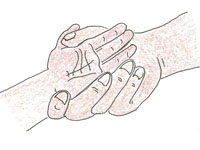7.4 Assessing for anaemia
There is one very clear way in which you can assess whether a sick child brought to your health post has anaemia, and this is to look for palmar pallor. Palmar pallor is unusual paleness of the skin of the palms. It is a sign of anaemia.
The steps for this are described below.
To see if the child has palmar pallor, look at the skin of the child’s palm. Hold the child’s palm open by grasping it gently from the side as illustrated in Figure 7.5. Do not stretch the fingers backwards. This may cause pallor by blocking the blood supply.

Compare the colour of the child’s palm with your own palm and with the palms of other children. If the skin of the child’s palm is pale, but has some pink areas, the child has some palmar pallor. If the skin of the palm is very pale or so pale that it looks white, the child has severe palmar pallor.
Box 7.1 below summarises the key points you have learned about how to assess for malnutrition and anaemia.
Box 7.1 Summary of assessment steps for malnutrition and anaemia
Malnutrition
Look and feel:
- For children under six months:
- Look for pitting oedema of both feet
- Look for visible severe wasting.
- For children aged six months or more:
- Look for pitting oedema of both feet
- Determine if the MUAC is less than 11.0 cm
- If the MUAC is less than 11.0 cm or there is oedema of both feet and there is no medical complication, you should assess the child’s appetite.
Anaemia
- Look for palmar pallor. If it is present, is it:
- Severe palmar pallor?
- Some palmar pallor?
7.3.5 Assessing appetite
